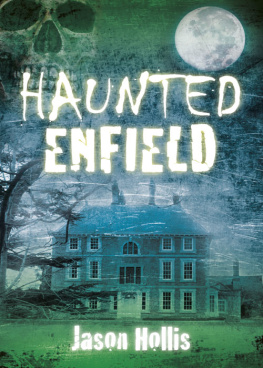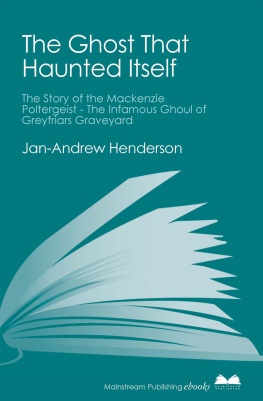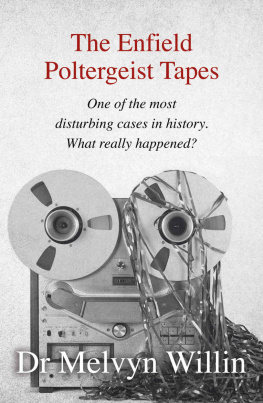First Published in the United Kingdom in 1980 by Souvenir Press Ltd.
2007 Edition published by The History Press Ltd.
Original Copyright 1980, 2007 by Guy Lyon Playfair. All rights reserved.
This White Crow Books Edition Copyright 2011 by Guy Lyon Playfair.
All rights reserved.
Published in the United States of America and the United Kingdom by White Crow Books; an imprint of White Crow Productions Ltd. No part of this book may be reproduced, copied or used in any form or manner whatsoever without written permission, except in the case of brief quotations in reviews and critical articles.
For information, contact White Crow Books at P. O. Box 1013 Guildford, GU1 9EJ United Kingdom, or e-mail .
A catalogue record for this book is available from the British Library.
What would you do if a piece of your furniture suddenly slid along the floor on its own in front of your eyes? Think for a moment and be honest with yourself. What would you actually do?
Maybe, after getting over the initial shock, you would shrug your shoulders, assume it must have had something to do with mice or an earthquake, and just hope it doesnt happen again.
But it does happen again. And again. And all sorts of even odder things happen as well. Stones fall on your kitchen floor, as if they had come through the ceiling. Somebody or something starts banging on the wall. Things disappear and reappear somewhere else. Before long, you realise that it cant be anything to do with earthquakes or mice, but must be something else, something wholly inexplicable and very frightening. You know these things cant happen yet you also know they are happening.
Whatever you would do next, or like to think you would, I can tell you what people who have found themselves in this predicament have done.
Quite often, they have simply panicked. In 1978 a Birmingham family abandoned the house in which they had lived happily for eleven years, refusing to set foot in it again. A South London couple rushed out of their brand new council flat leaving their furniture and most of their belongings behind, and were never seen in the area again.
Others have appealed for help from neighbours, the police, priests, doctors and newspapers, but in vain. Sometimes, in fact, such appeals have only made things worse. As word spreads around that something spooky is going on in your house, you suddenly find your friends pointedly looking the other way when you pass them in the street. People give you funny looks in the local shops. Passers-by stop and stare at your house. You receive malicious phone calls and threatening letters. In short, your life is ruined. This has all happened.
Some have been even more unfortunate. They have been referred to psychiatrists and locked up in mental homes, as happened to a London woman in 1977. Then to crown it all they see some expert on television, usually a psychology professor, explaining that its all due to imagination or naughty children.
Yet a few are lucky. They find somebody who explains that what has been going on is known as poltergeist activity and is willing to help. Cases of such activity have been reported, often in considerable detail, for at least 1,500 years. It usually stops as suddenly and mysteriously as it starts, typically after a few days or maybe a couple of weeks, and it seldom does any serious damage. There are of course exceptions, and this book is about one of them.
Very briefly, can you explain what a poltergeist is?
I often get asked this question and my answer is invariably Very briefly, no. Nor can anyone else. As Bertrand Russell commented about the subject of electricity, it is not a thing, but a way in which things behave.
I can at least explain what the word means. It comes from the German verb poltern to make a racket and Geist spirit or ghost. I can also describe how poltergeists behave. They seem to come in three or four varieties. They can be merely mischievous, they can give the impression that they just dropped in by chance, they can even be benevolent in an extraordinary case in South Wales investigated by my late colleague David Fontana in 1991, quite a large sum of money in the form of coins and even banknotes was provided by the obliging spook. Yet they can also be thoroughly hostile and destructive, as on a case I helped investigate in Brazil in 1973 when a family in the town of Suzano had much of their furniture destroyed by repeated outbreaks of fire and several windows and roof tiles smashed by stones thrown by invisible hands.
What they generally do most often is knock on walls and floors, throw things around, overturn chairs and tables, set things on fire, and occasionally, as we shall see, give the impression that they are spirits of the dead, for want of a more precise description.
Poltergeist activity is in fact what doctors call a syndrome, which means a group of symptoms that indicate a certain disease or an abnormal condition. And it is not only abnormal, meaning not normal, but also paranormal. This means that it cannot be explained in terms of established science, which in turn means that established scientists tend to ignore it altogether and pretend that it doesnt exist (because they cant explain it), leaving the work of investigation to individuals like myself who are intrigued by areas of human experience that scientists generally cannot reach.
The Enfield poltergeist made the front page of a national newspaper ten days after it began in 1977. It has been the subject of numerous radio and television programmes and even more numerous newspaper and magazine articles all over the world. It is also the subject of a full-length book this one.
The reason for all this attention is that an enormous amount of very anomalous activity took place over a period of some fifteen months in 1977 and 1978, including examples of just about every psychic phenomenon on record. Much it was taperecorded as it happened, and some of it was photographed by an experienced professional. Some was even captured on film, and a great deal of it was witnessed in good conditions by at least thirty people including myself. Andrew Green, a leading authority on these matters, described the case in New Psychologist (January 1979) as promising to be the most exciting poltergeist case yet. I hope this book helps fulfil that promise.
But before I get down to a thud-by-crash account of all the activity and excitement, a word of caution is needed. If you are not sated by all the horrors and occult titillations of books or films such as The Exorcist and its host of imitators, and are still hungry for more exotic thrills, then this book is not for you. Readers may find some of it rather dull, with a not very good plot and some terrible dialogue.
This is because This House is Haunted, plot, dialogue and all, is true. And while truth may be stranger than fiction, as indeed it can be, it is also far less well organised. It can be very repetitive, even monotonous. It is exciting enough when a table or a sofa leaps into the air and flips over, but when such incidents keep on happening week after week, it becomes a bit of a bore.
So, if you are tired of all the over-dramatised versions of what were sometimes true events, and would like to know what really happens on a poltergeist case from start to finish in some detail, please read on, but bear two things in mind:










